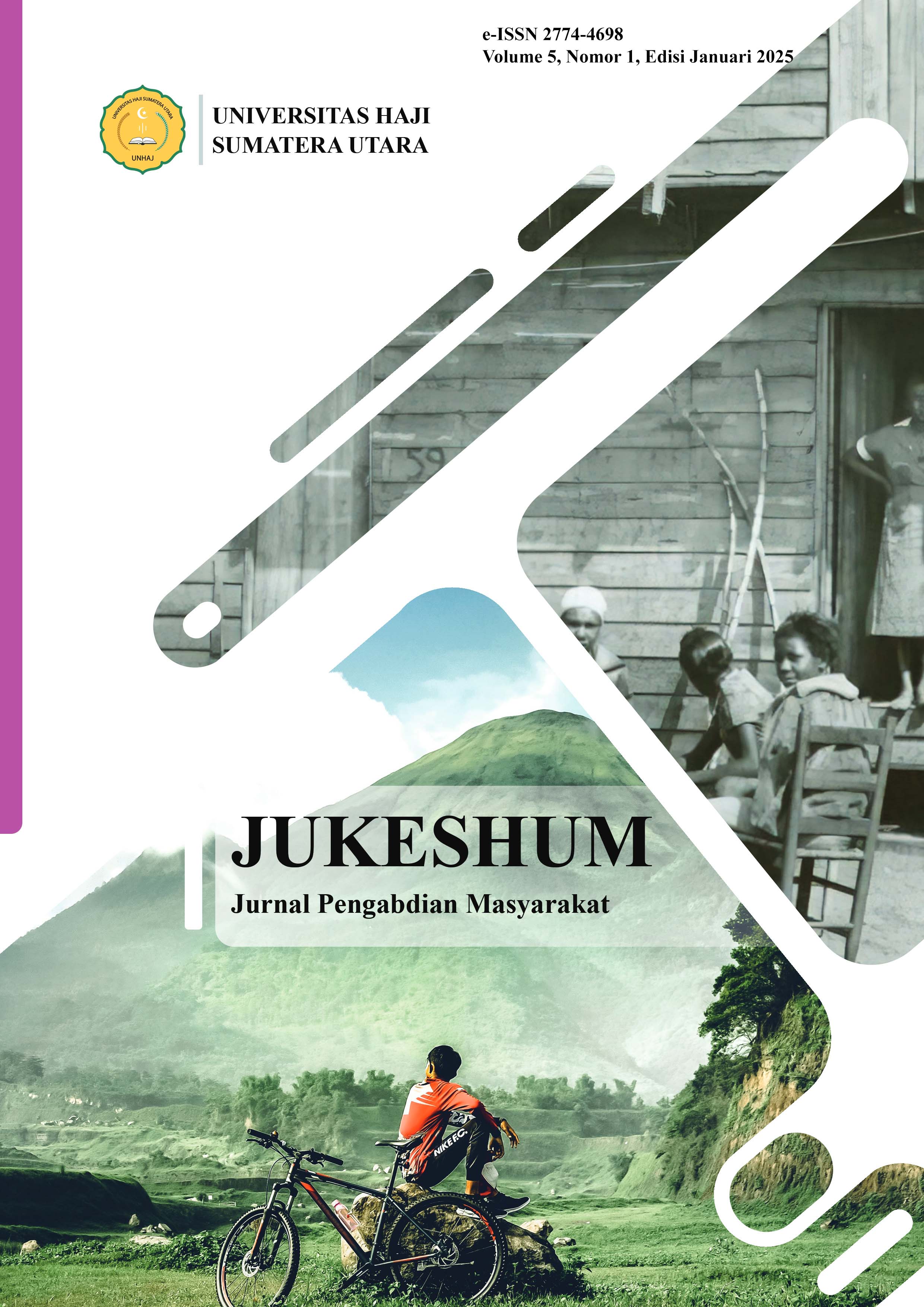GEMAR CETING (Healthy and Nutritious Food Movement Prevents Wasting) in School-Age Children at Public Elementary School 104209 Saentis
GEMAR CETING (Gerakan Makanan Sehat dan Bergizi Mencegah Wasting) Pada Anak Usia Sekolah di SD Negeri 104209 Saentis
DOI:
https://doi.org/10.51771/jukeshum.v5i1.1207Keywords:
Children, Healthy Snacks, Healthy Food, Growth and Development, WastingAbstract
Nutritional problems are a global health problem that occurs almost all over the world. The impact of malnutrition will inhibit the growth process in children such as stunting and wasting, which results in a level of intelligence that is not optimal and is more susceptible to disease due to an imperfect immune system. The GEMAR CETING activity (healthy and nutritious food movement to prevent wasting) for school children is a form of health promotion activity with an educational method through counseling. From the results of observations, the problem of wasting also occurred at SD Negeri 104209 Saentis, where more than 40 out of 352 children were found to have a thin body posture, weight far below the standard growth curve or weight based on height. The purpose of this service is to increase knowledge for teachers and students about healthy and nutritious food in daily meals and the dangers of consuming unhealthy foods. The results of this service found 4 problems, namely low knowledge about wasting, not eating breakfast, unhealthy snacks and low knowledge related to child growth and development. In this service, GEMAR CETING was held by providing education to children through interesting educational videos about wasting, the importance of breakfast, healthy food and assessing child growth and development. Health promotion media is also provided to parents and teachers through leaflets and posters in the school environment. Based on the education that has been provided through educational videos, it shows that the percentage of questionnaire results on knowledge of 4 educational topics from 52.5% increased to 84.6%. The conclusion in this service is the importance of teacher involvement in detecting child growth and development and also monitoring children's snacks. Institutional support is very important in improving health promotion about healthy food and wasting.
References
Aini, S. Q. (2019). Perilaku Jajan Pada Anak Sekolah Dasar. Jurnal Litbang: Media Informasi Penelitian, Pengembangan Dan IPTEK, 15(2), 133–146. doi:10.33658/jl.v15i2.153
Anisa, N., & Ramadhan, Z. H. (2021). Peran Kepala Sekolah dan Guru dalam Menumbuhkan PHBS pada Siswa (SD). Jurnal Basicedu, 5(4), 2263–2269.
Budiarti, E. (2022). Meningkatkan Pemahaman Pentingnya Makan Makanan Bergizi Seimbang Melalui Kegiatan Makan Bersama. Jurnal Inovasi Riset Ilmu Kesehatan, 1(4), 218–229.
Iqbal, S, M. (2023). Edukasi Pentingnya Makanan Bergizi Dan Memilih Jajanan Sehat Bagi Anak Usia Sekolah. Jurnal Pengabdian Ilmu Kesehatan (JPIKes), 3(3), 1–9.
Kasingku, D., W., & Lumoindong, W. (2023). Peran Penting Pendidikan Lewat Makanan Bergizi dalam Meningkatkan Kesadaran Masyarakat akan Kesehatan Tubuh dan Pikiran. Jurnal Teknologi Informasi, 10(1), 16071–16080.
Kasingku, D. (2023). Peran Makanan Sehat Dalam Meningkatkan Kesehatan Fisik dan Kerohanian Pelajar. Jurnal Pendidikan Mandala, 3, 853–859.
Novianti, G., P. (2022). Diet Makanan Sehat Sesuai Golongan Darah Dengan Pemanfaatan Teknologi Berbasis Mobile. Jurnal Teknologi Informasi, 10, 1–9.
Okafor, O, .C. (2023). Prevalence of Wasting and Underweight Amongst Preschool Aged Children in Awka South LGA, Anambra State, Nigeria. IAA Journal of Biological Sciences, 10(1), 61–67.
Onur. O. (2021). The Role of Nutrition Education in School-age Children in the Prevention of Global Obesity Epidemic. American Journal of Public Health Research, 9(3), 114–119.
Sumarni, N., Rosidin, U., & Sumarna, U. (2020). Penguatan Kapasitas Siswa Sd Jati Iii Tarogong Dalam Upaya Meningkatkan Kewaspadaan Pada Jajanan Tidak Sehat. Kumawula: Jurnal Pengabdian Kepada Masyarakat, 3(2), 289. doi:10.24198/kumawula.v3i2.28026
Downloads
Published
Issue
Section
License
Copyright (c) 2025 Sarida Manurung, Risatantry Gultom, Christina Magdalena T Bolon, Puput Melati, Wellina BR. Sebayang

This work is licensed under a Creative Commons Attribution-ShareAlike 4.0 International License.
Hak Cipta dan Lisensi
Penulis yang mempublikasikan naskahnya melalui Jukeshum: Jurnal Pengabdian Masyarakat menyetujui beberapa hal berikut:
- Hak Cipta atas naskah-naskah karya ilmiah di dalam Jurnal ini dipegang oleh Penulis.
- Penulis menyerahkan hak saat pertama kali mempublikasi Naskah karya ilmiahnya dan secara bersamaan Penulis memberikan izin/lisensi dengan mengacu pada Creative Commons Attribution-ShareAlike 4.0 International License kepada pihak lain untuk menyebarkan karya ilmiahnya tersebut dengan tetap mencantumkan penghargaan bagi penulis dan Jukeshum: Jurnal Pengabdian Masyarakat sebagai media Publikasi pertama atas karya tersebut.
- Hal-hal yang berkaitan dengan non-eksklusivitas pendistribusian Jurnal yang menerbitkan karya ilmiah penulis dapat diperjanjikan secara terpisah (contoh: permintaan untuk menempatkan karya yang dimaksud pada perpustakaan suatu institusi atau menerbitkannya sebagai buku) dengan Penulis sebagai salah satu pihak perjanjian dan dengan penghargaan pada Jukeshum: Jurnal Pengabdian Masyarakat sebagai media publikasi pertama atas karya dimaksud.
- Penulis dapat dan diharapkan untuk mengumumkan karyanya secara online (misalnya pada Repositori atau pada laman Organisai/Institusinya) sejak sebelum dan selama proses pengumpulan naskah, sebab upaya tersebut dapat meningkatkan pertukaran citasi lebih awal dan dengan cakupan yang lebih luas.








